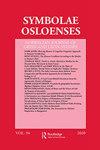The Herme-Neutics of Χοιροκομεῖον in Aristophanes’ Lysistrata
IF 0.1
3区 历史学
0 CLASSICS
引用次数: 0
Abstract
The following paper discusses the meaning of the word χοιροκομεῖον and its function in a passage in Aristophanes’ Lysistrata 1073. Although its semantics became obscure as early as the time of Pollux, it almost certainly originally referred to a wicker-work pigpen. The fact that in the Aristophanic passage under discussion the Spartan delegates are said to be wearing it around their thighs suggests that the author meant it to be an obscene joke based on a stereotype according to which, unlike the Athenians, the Spartans were very likely to become sexual objects for other males. Within the reconstruction proposed below they wore χοιροκομεῖα in order to protect themselves from penetration. This element, combined with the other aspects of the visual characteristics of the Spartan delegates, namely erect phalli and long beards, made them similar to the herms of Hermes.阿里斯托芬《Lysistrata》中Hoirokomeion的Herme Neutics
本文讨论了χῖμ及其在阿里斯托芬的《利西斯特拉塔》1073中的一段话中的作用。尽管它的语义早在Pollux时代就变得晦涩难懂,但几乎可以肯定的是,它最初指的是柳条作品猪圈。事实上,在讨论中的阿里斯托芬段落中,斯巴达代表据说把它戴在大腿上,这表明作者的意思是这是一个基于刻板印象的淫秽笑话,根据刻板印象,与雅典人不同,斯巴达人很可能成为其他男性的性对象。在下面提出的重建中,他们佩戴了χῖα,以保护自己不被穿透。这种元素,再加上斯巴达代表的其他视觉特征,即直立的阳具和长胡子,使他们与赫尔墨斯的赫尔墨斯相似。
本文章由计算机程序翻译,如有差异,请以英文原文为准。
求助全文
约1分钟内获得全文
求助全文

 求助内容:
求助内容: 应助结果提醒方式:
应助结果提醒方式:


